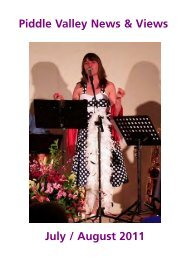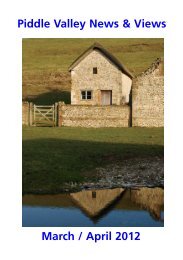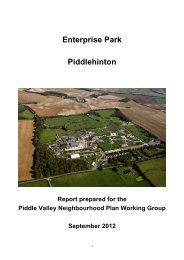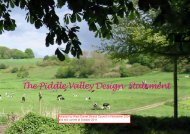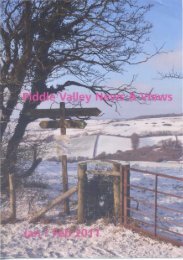Jan/Feb - Piddle Valley Community Website
Jan/Feb - Piddle Valley Community Website
Jan/Feb - Piddle Valley Community Website
Create successful ePaper yourself
Turn your PDF publications into a flip-book with our unique Google optimized e-Paper software.
wheelwright whilst my grandfather did the blacksmithing. After William<br />
retired Charles was obliged to turn his hand to shoeing. The iron for the<br />
shoes was supplied by Thomas Reynolds in Bristol and arrived by train at<br />
Dorchester where Harry Hawker’s carrier’s cart collected it and transported it<br />
back on the roof to the forge. Timber was collected in the same way on<br />
Thursday afternoons (Early Closing Day in Dorchester) from Hutchings Sawmill<br />
in Hazelbury Bryan. The plank shed was behind the house and was used to<br />
store the timber whilst it was seasoned. This building was at right-angles to<br />
the house and made of wood and tiles<br />
I remember in the Forge hand bellows being used until we had electricity.<br />
There was a second forge although I don’t recall seeing it in use. When a long<br />
piece of iron was being worked it was passed through the archway into the<br />
forge through a little wooden hatch opened on the door by the road. The<br />
village was very quiet in those days with little traffic! The entrance for<br />
customers was where it is now; wheel-bonding took place in the outside area.<br />
Wilf, Harry Hawker’s son, used to do odd jobs for us and helped with wheelbonding,<br />
hammering, pouring water on to cool the metal and even<br />
gardening. My granddad used to call him Snowball because of his blond hair!<br />
The Forge was always a very busy place: shoeing the horses as all the farms<br />
had several horses and no tractors in the 1920’s! Also wheel bonding, the<br />
children used to love watching that. My Dad used to build waggons and putt<br />
carts or dung putts. I used to enjoy watching him in the carpenter’s shop,<br />
rather than when he was shoeing the horses, although they stood very<br />
quietly. My earliest memory is my grandfather doing the shoeing until he<br />
retired in 1920’s then my Dad took over and later my late brother, George.<br />
The forge had a great fascination to the children coming from school, looking<br />
over the half door. Probably the fire was some attraction, kept alight by large<br />
bellows which were pumped by hand until electricity arrived in the 1930’s.<br />
What a relief this must have been! Wheel bonding was a big event. The<br />
Bonding Stone was in the yard over which the wooden wheel was put. The<br />
Iron Bond was heated and shut in the fire, then carried out to the wheel<br />
whilst still hot and put on the wheel. A lot of hammering-sledge hammers<br />
and then cold water was poured on to shrink<br />
tight. This took several men!<br />
The garden behind the house was planted<br />
right to the top. Sometimes my friends and I<br />
used to go to school or come home this way,<br />
running along the edge of Closes and down<br />
Tullons Lane. Grandad had a large fruit cage<br />
half way up the garden. I expect that was<br />
the attraction !<br />
Bridget + Dave Bowen<br />
‘ Aunty Joan’<br />
© Rachel Hunt<br />
53



